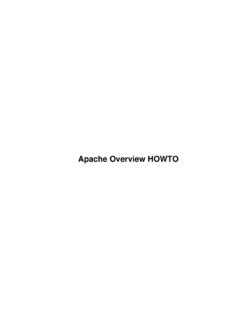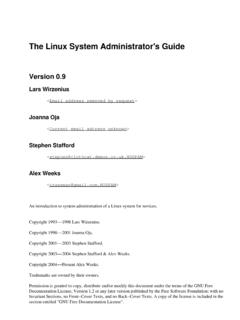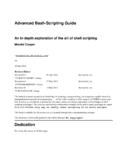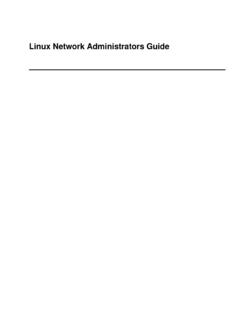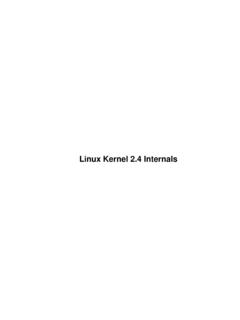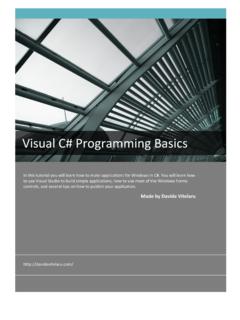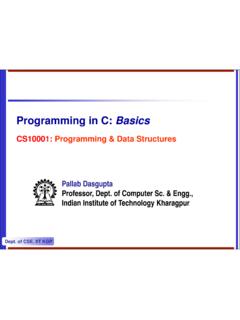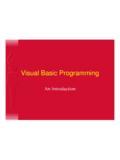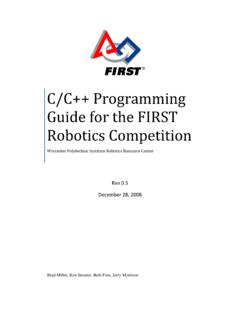Transcription of The Linux Kernel Module Programming Guide
1 The Linux Kernel Module Programming GuidePeter Jay SalzmanMichael BurianOri PomerantzCopyright 2001 Peter Jay Salzman2007 05 18 ver Linux Kernel Module Programming Guide is a free book; you may reproduce and/or modify it under theterms of the Open Software License, version You can obtain a copy of this license book is distributed in the hope it will be useful, but without any warranty, without even the impliedwarranty of merchantability or fitness for a particular author encourages wide distribution of this book for personal or commercial use, provided the abovecopyright notice remains intact and the method adheres to the provisions of the Open Software License. Insummary, you may copy and distribute this book free of charge or for a profit.
2 No explicit permission isrequired from the author for reproduction of this book in any medium, physical or works and translations of this document must be placed under the Open Software License, and theoriginal copyright notice must remain intact. If you have contributed new material to this book, you mustmake the material and source code available for your revisions. Please make revisions and updates availabledirectly to the document maintainer, Peter Jay Salzman This will allow for the merging ofupdates and provide consistent revisions to the Linux you publish or distribute this book commercially, donations, royalties, and/or printed copies are greatlyappreciated by the author and the Linux Documentation Project (LDP).
3 Contributing in this way shows yoursupport for free software and the LDP. If you have questions or comments, please contact the address of Versioning and 1. What Is A Kernel Module ?.. How Do Modules Get Into The Kernel ?.. Before We 2. Hello Hello, World (part 1): The Simplest Introducingprintk().. Compiling Kernel Hello World (part 2).. Hello World (part 3): The__init and__exit Hello World (part 4): Licensing and Module Passing Command Line Arguments to a Modules Spanning Multiple Building modules for a precompiled 3. Modules vs How modules begin and Functions available to User Space vs Kernel Name Code Device 4. Character Device Character Device The file_operations The file Registering A Unregistering A Writing Modules for Multiple Kernel 5.
4 The /proc File The /proc File Read and Write a /proc Manage /proc file with standard Manage /proc file with 6. Using /proc For TODO: Write a chapter about Linux Kernel Module Programming GuideiTable of ContentsChapter 7. Talking To Device Talking to Device Files (writes and IOCTLs)..41 Chapter 8. System System 9. Blocking Blocking 10. Replacing Flashing keyboard 11. Scheduling Scheduling 12. Interrupt Interrupt Interrupt Keyboards on the Intel 13. Symmetric Multi Symmetrical Multi 14. Common Common A. Changes: To Changes between and Changes between and B. Where To Go From Where From Here?..79 The Linux Kernel Module Programming GuideiiForeword1.
5 AuthorshipThe Linux Kernel Module Programming Guide was originally written for the kernels by Ori , Ori no longer had time to maintain the document. After all, the Linux Kernel is a fast movingtarget. Peter Jay Salzman took over maintenance and updated it for the kernels. Eventually, Peter nolonger had time to follow developments with the Kernel , so Michael Burian became a co maintainer toupdate the document for the Versioning and NotesThe Linux Kernel is a moving target. There has always been a question whether the LKMPG should removedeprecated information or keep it around for historical sake. Michael Burian and I decided to create a newbranch of the LKMPG for each new stable Kernel version.
6 So version LKMPG will address Linux and LKMPG will address Linux Kernel No attempt will be made to archive historicalinformation; a person wishing this information should read the appropriately versioned source code and discussions should apply to most architectures, but I can't promise anything. Oneexception is Chapter 12, Interrupt Handlers, which should not work on any architecture except for AcknowledgementsThe following people have contributed corrections or good suggestions: Ignacio Martin, David Porter, DanielePaolo Scarpazza, Dimo Velev, Francois Audeon and Horst 1. What Is A Kernel Module ?So, you want to write a Kernel Module . You know C, you've written a few normal programs to run asprocesses, and now you want to get to where the real action is, to where a single wild pointer can wipe outyour file system and a core dump means a exactly is a Kernel Module ?
7 Modules are pieces of code that can be loaded and unloaded into the kernelupon demand. They extend the functionality of the Kernel without the need to reboot the system. For example,one type of Module is the device driver, which allows the Kernel to access hardware connected to the modules, we would have to build monolithic kernels and add new functionality directly into thekernel image. Besides having larger kernels, this has the disadvantage of requiring us to rebuild and reboot thekernel every time we want new How Do Modules Get Into The Kernel ?You can see what modules are already loaded into the Kernel by running lsmod, which gets its information byreading the file / do these modules find their way into the Kernel ?
8 When the Kernel needs a feature that is not resident inthe Kernel , the Kernel Module daemon kmod[1] execs modprobe to load the Module in. modprobe is passed astring in one of two forms:A Module name like softdog or ppp. A more generic identifier like char major 10 30. If modprobe is handed a generic identifier, it first looks for that string in the file/ [2] If it finds an alias line like:alias char major 10 30 softdogit knows that the generic identifier refers to the Module , modprobe looks through the file /lib/modules/ , to see if othermodules must be loaded before the requested Module may be loaded. This file is created by depmod a andcontains Module dependencies. For example, requires the Module to be already loadedinto the Kernel .
9 The requested Module has a dependency on another Module if the other Module definessymbols (variables or functions) that the requested Module , modprobe uses insmod to first load any prerequisite modules into the Kernel , and then the requestedmodule. modprobe directs insmod to /lib/modules/version/[3], the standard directory for is intended to be fairly dumb about the location of modules, whereas modprobe is aware of the defaultlocation of modules, knows how to figure out the dependencies and load the modules in the right order. So forexample, if you wanted to load the msdos Module , you'd have to either run:insmod /lib/ /lib/ 1. Introduction2or:modprobe msdosWhat we've seen here is: insmod requires you to pass it the full pathname and to insert the modules in theright order, while modprobe just takes the name, without any extension, and figures out all it needs to knowby parsing /lib/modules/ distros provide modprobe, insmod and depmod as a package called Module init tools.
10 In previousversions that package was called modutils. Some distros also set up some wrappers that allow both packagesto be installed in parallel and do the right thing in order to be able to deal with and kernels. Usersshould not need to care about the details, as long as they're running recent versions of those you know how modules get into the Kernel . There's a bit more to the story if you want to write your ownmodules which depend on other modules (we calling this `stacking modules'). But this will have to wait for afuture chapter. We have a lot to cover before addressing this relatively high level Before We BeginBefore we delve into code, there are a few issues we need to cover. Everyone's system is different andeveryone has their own groove.
